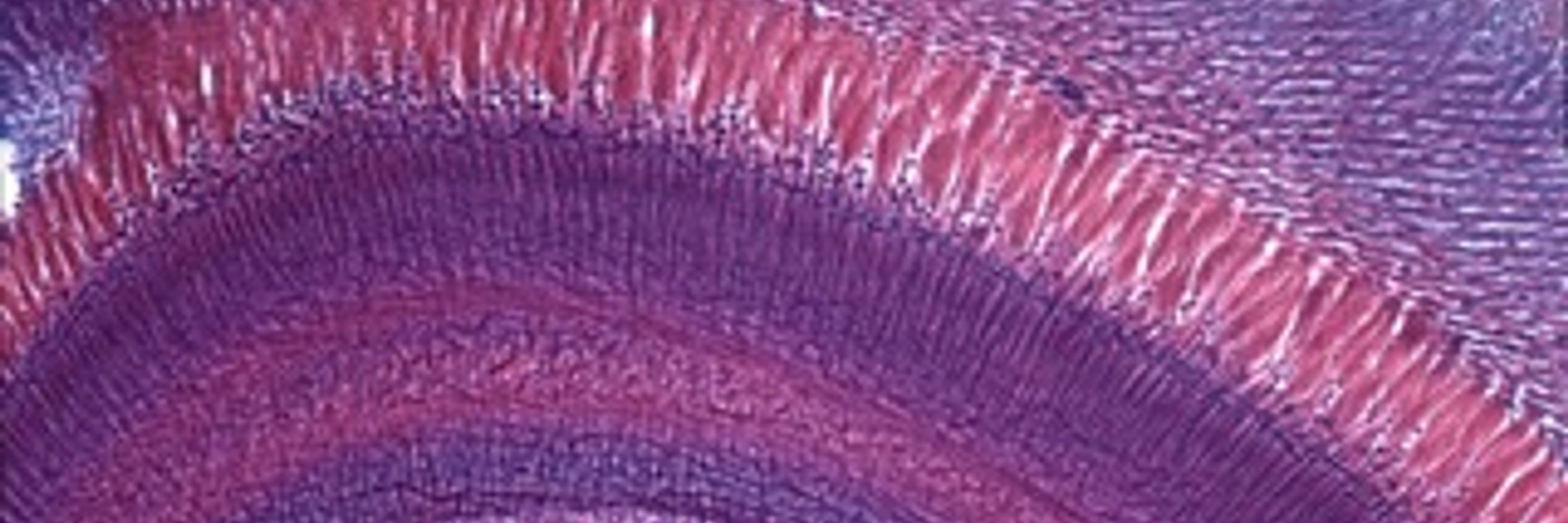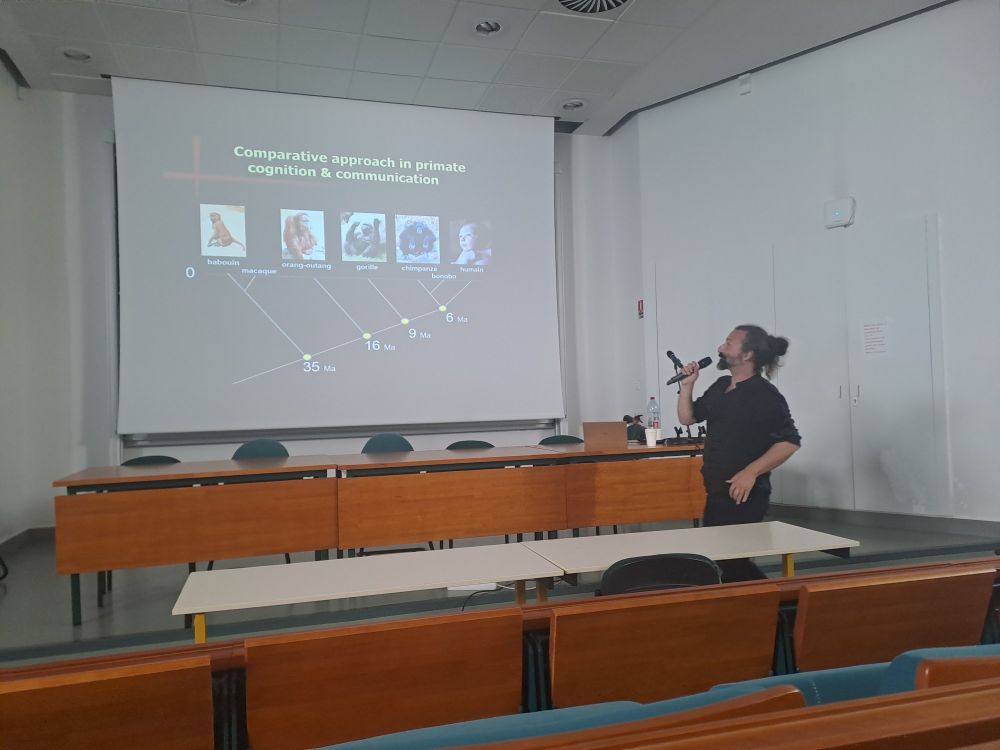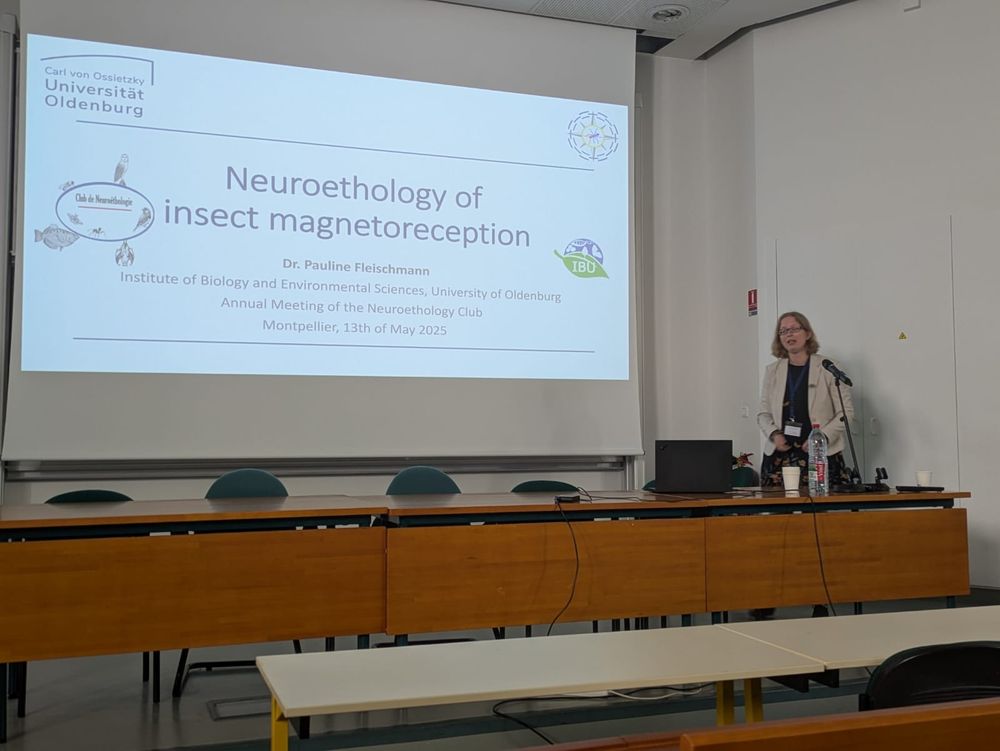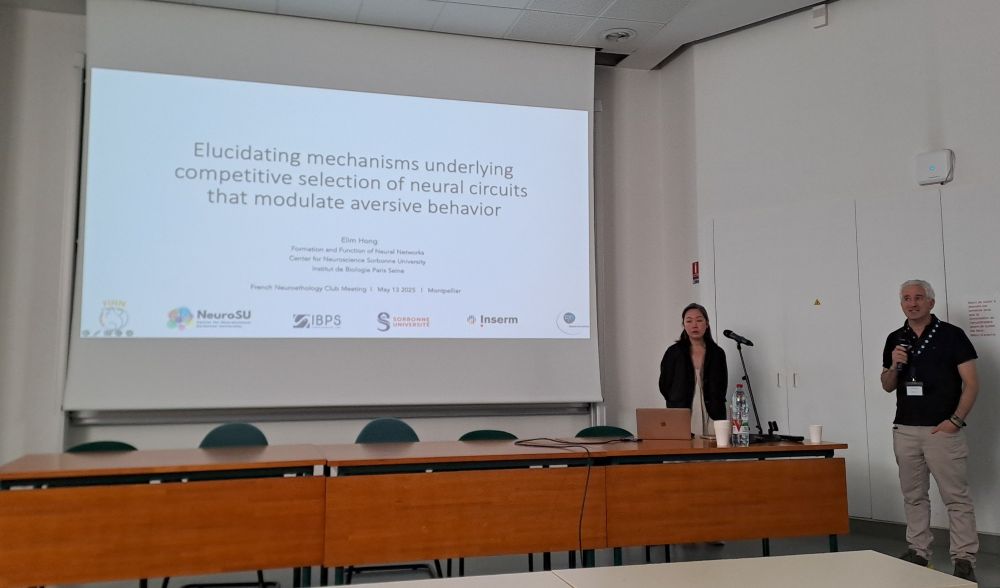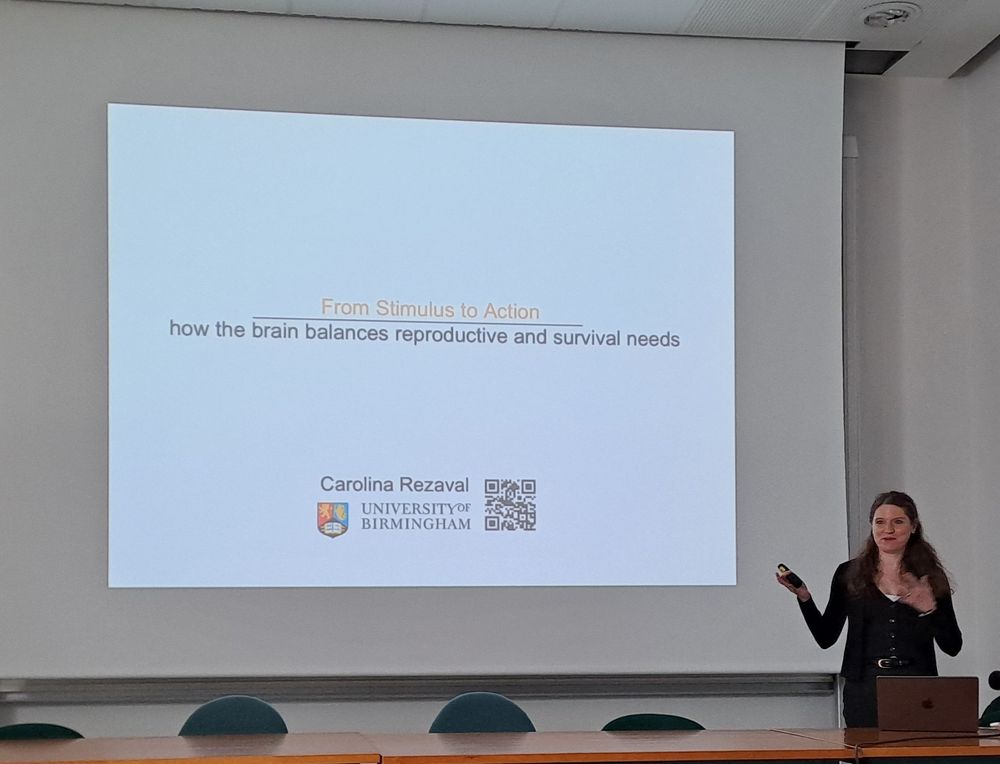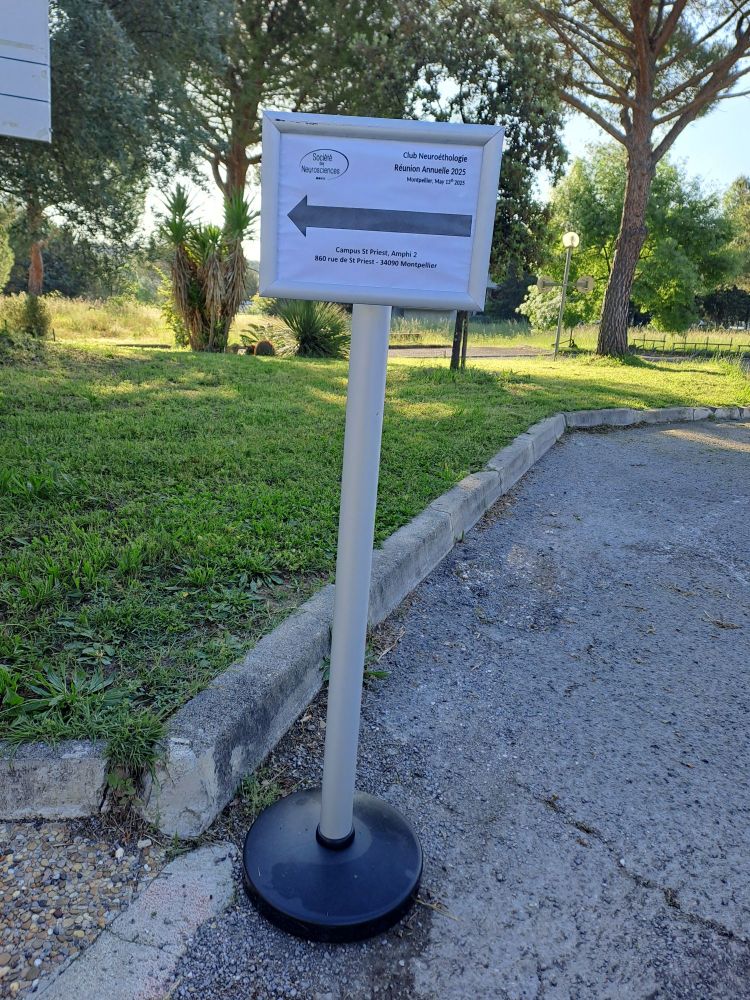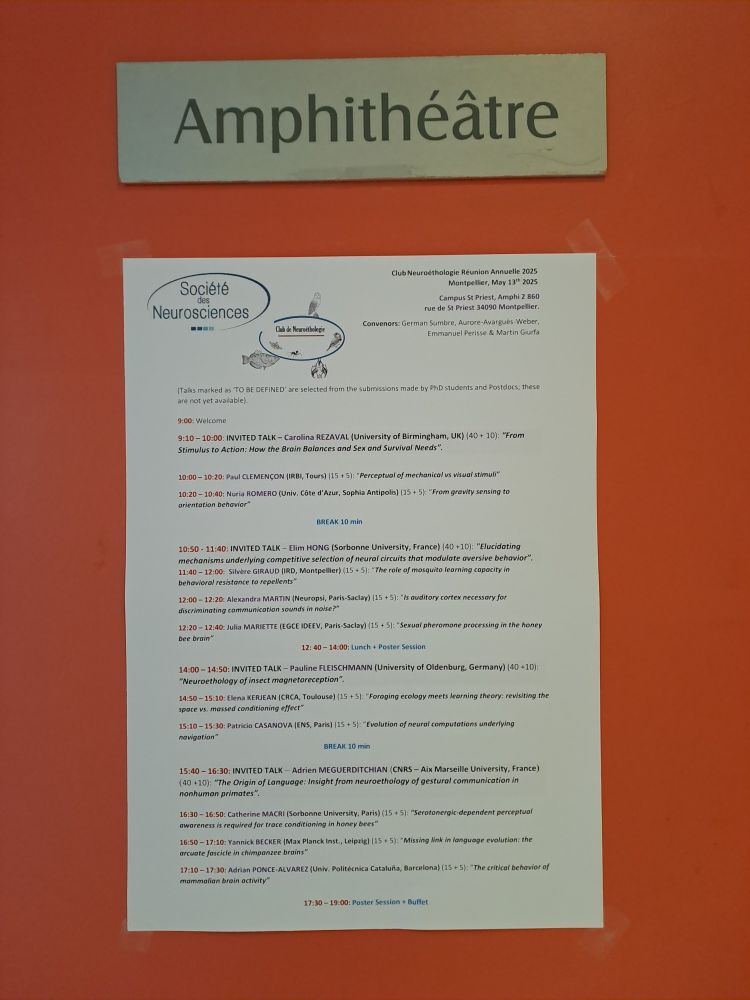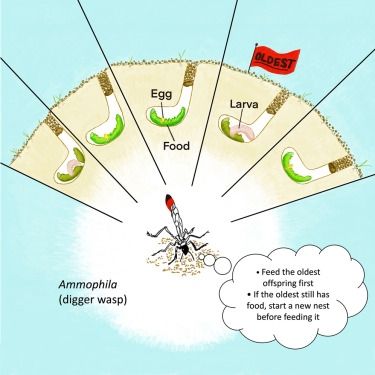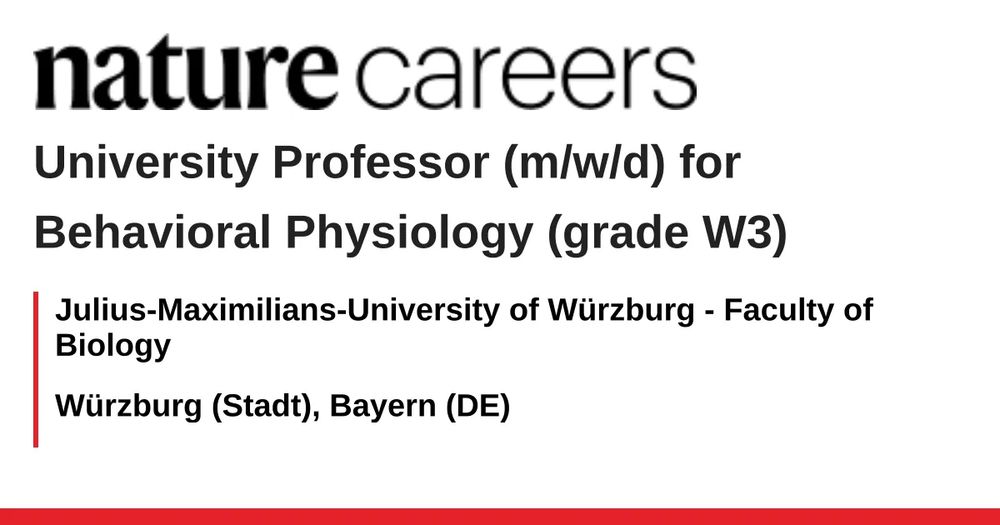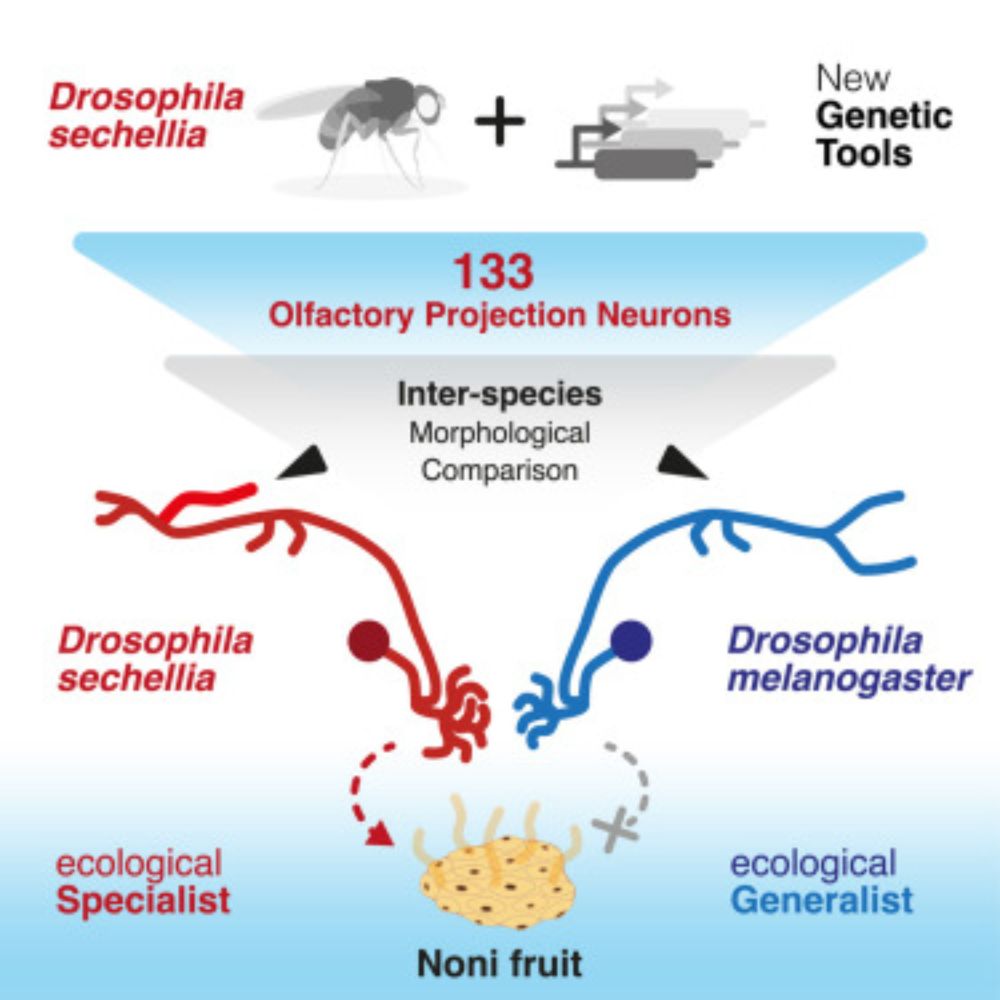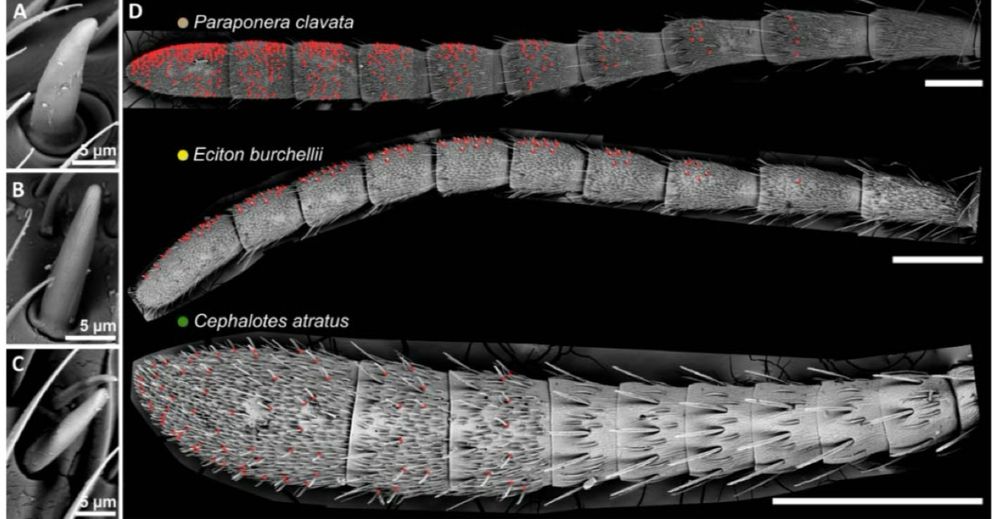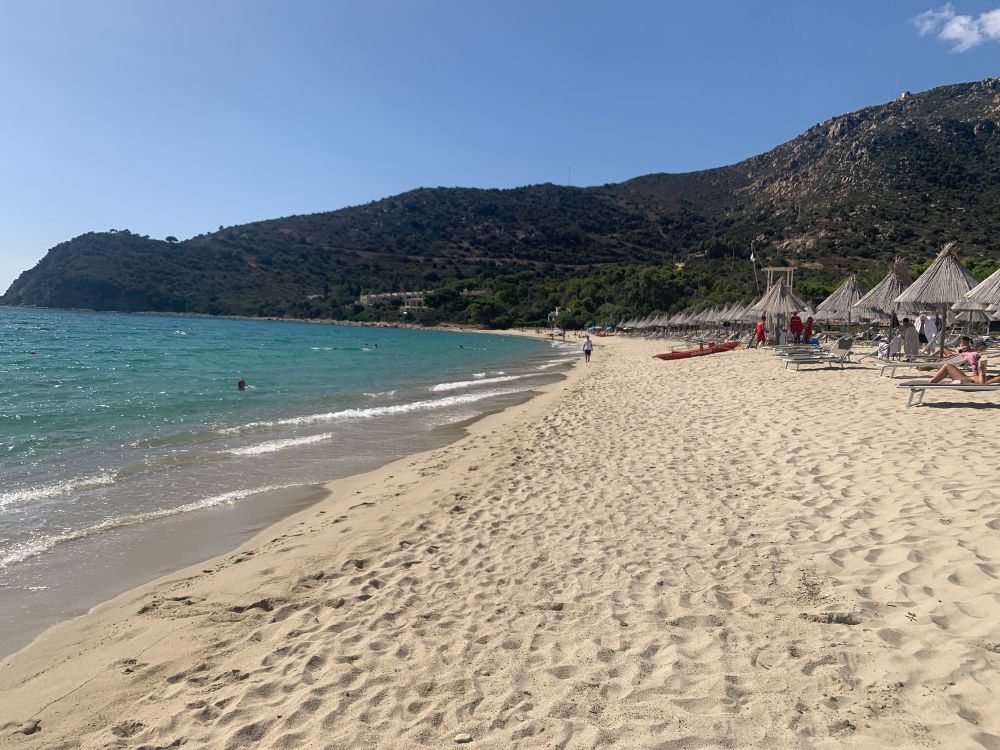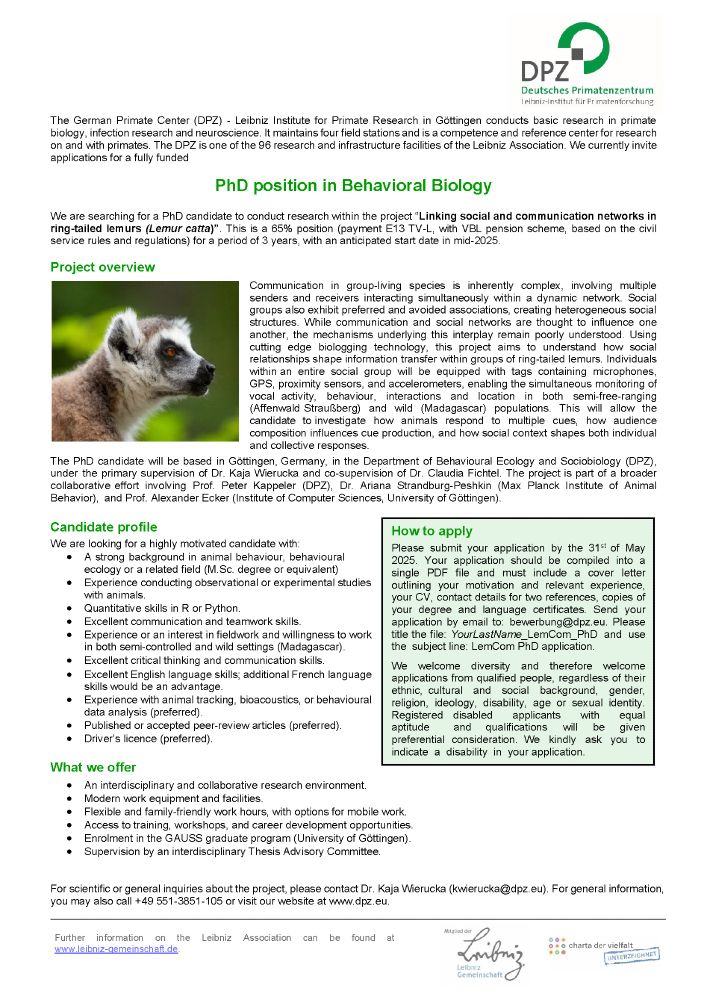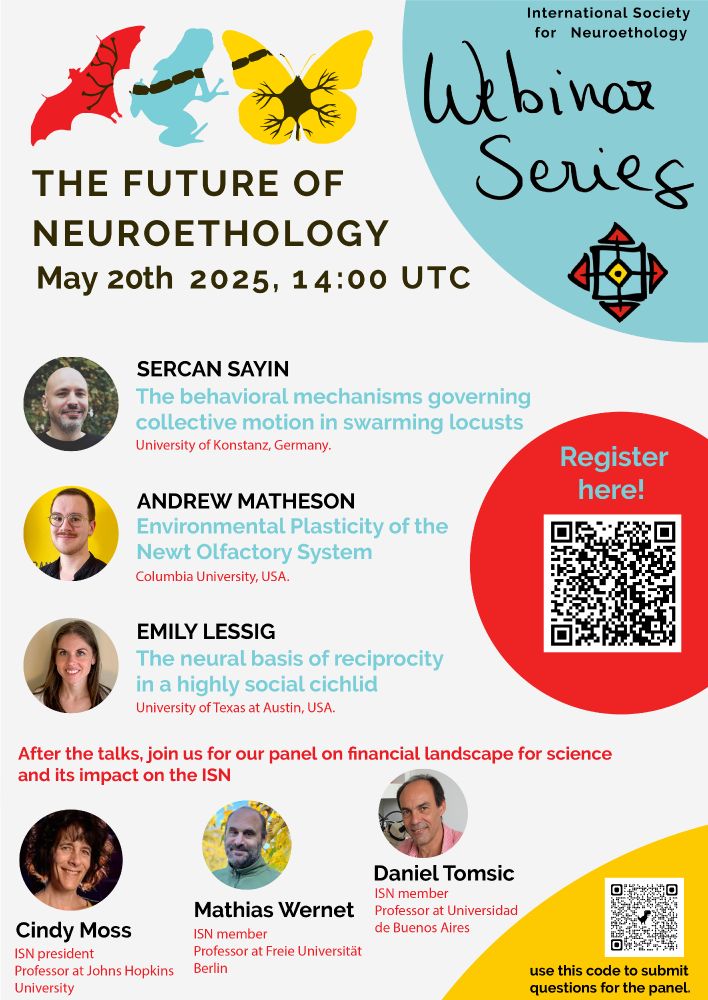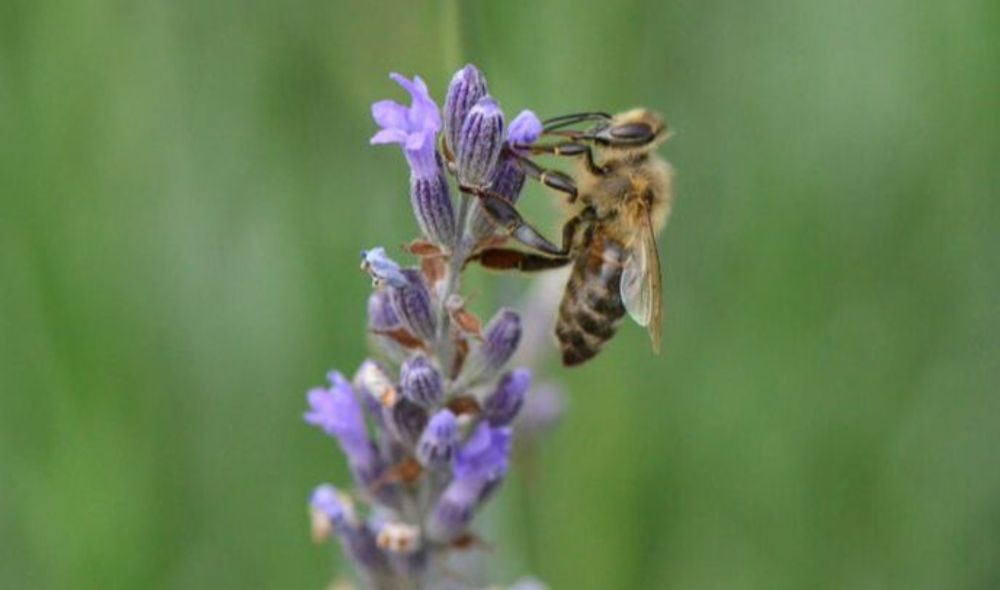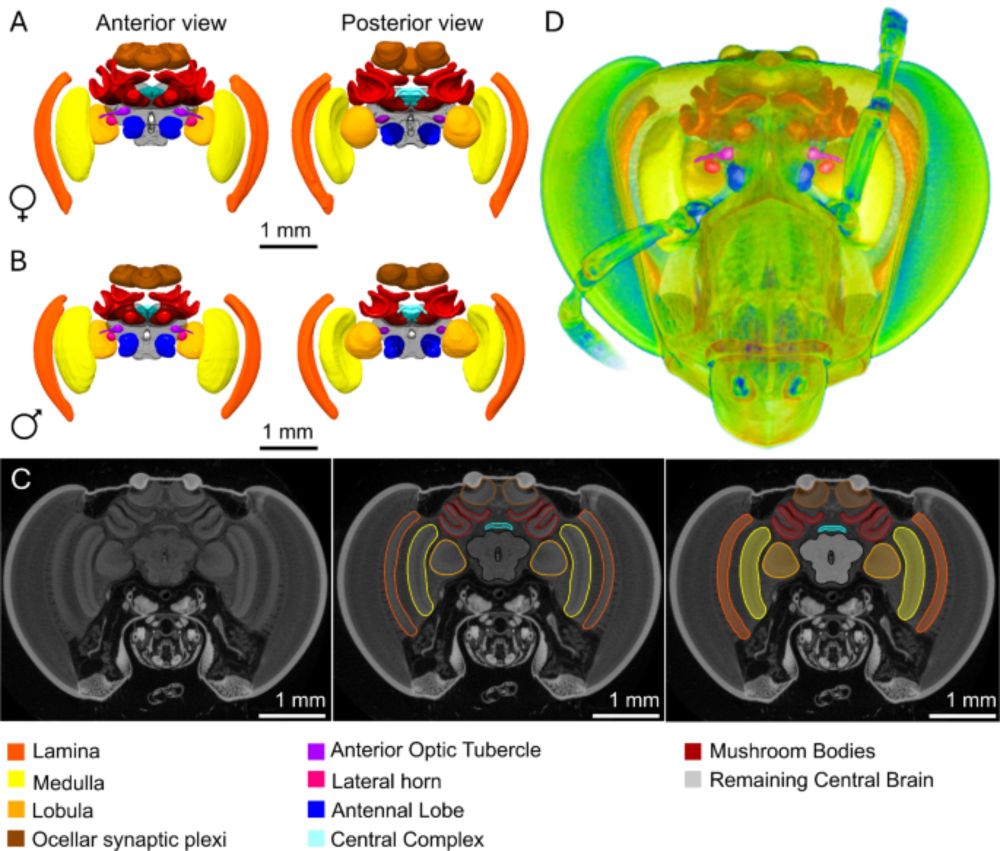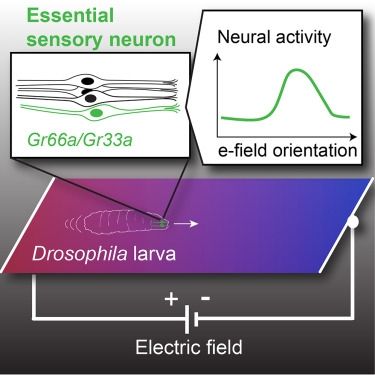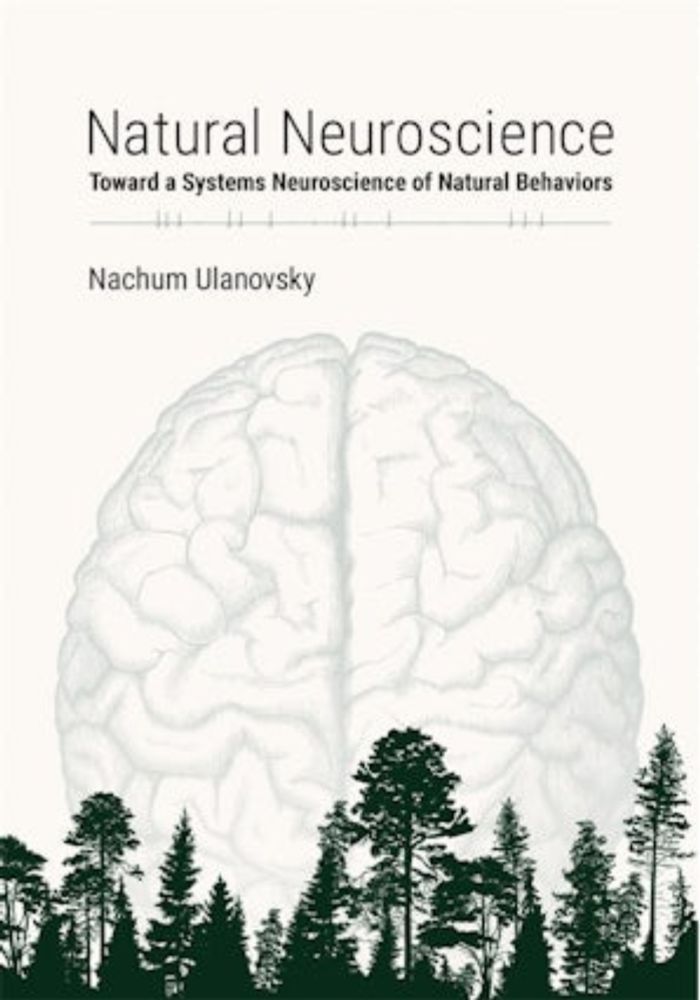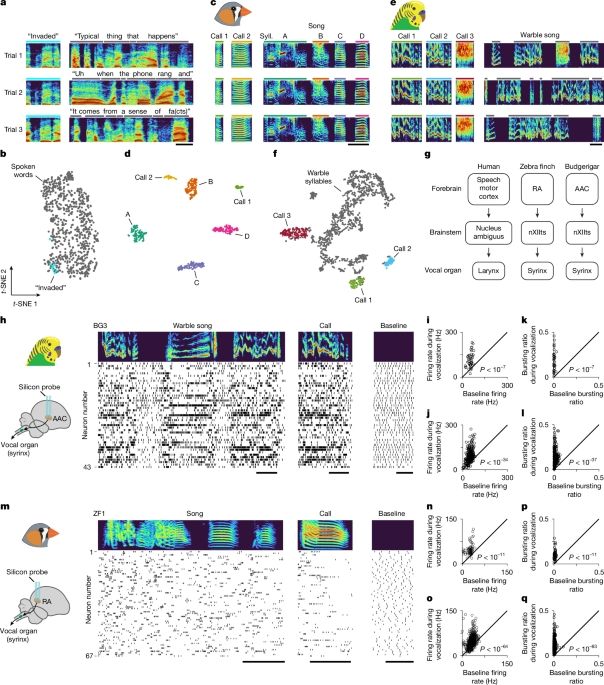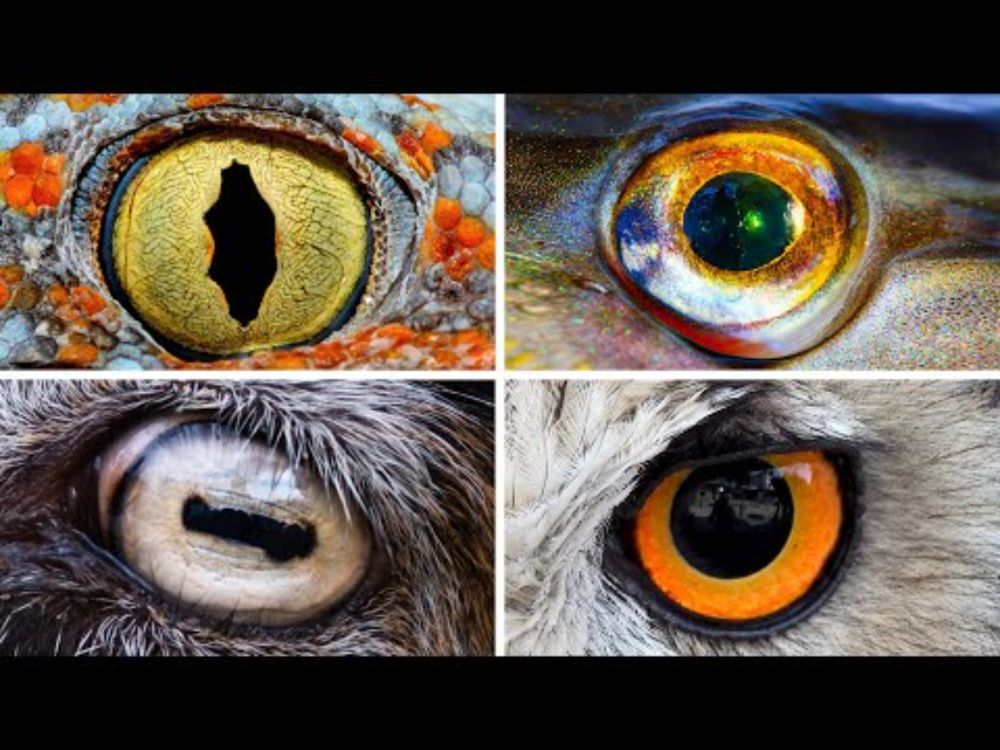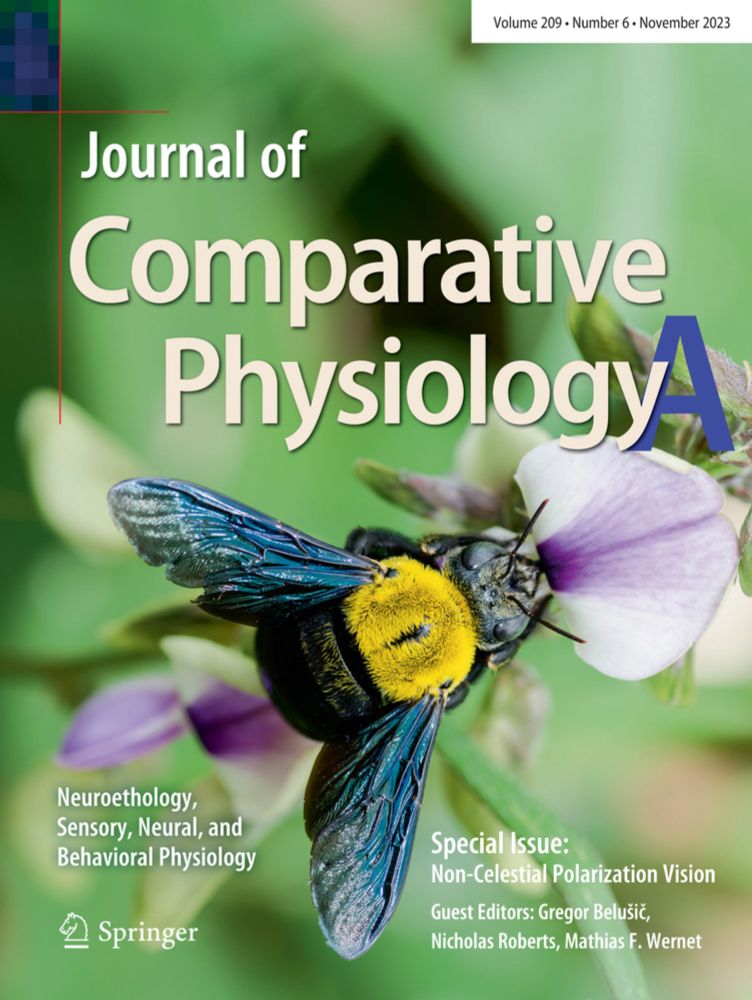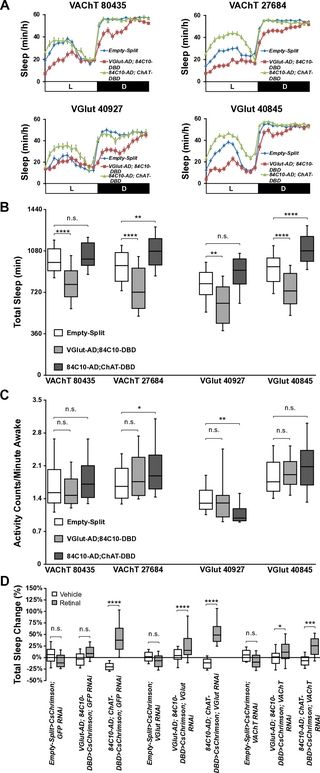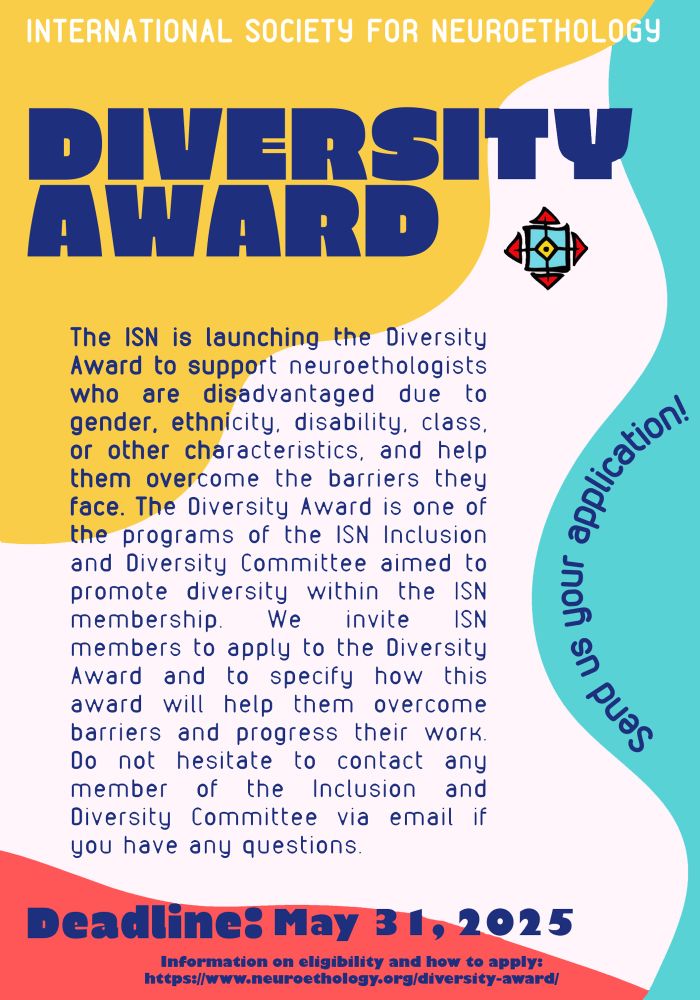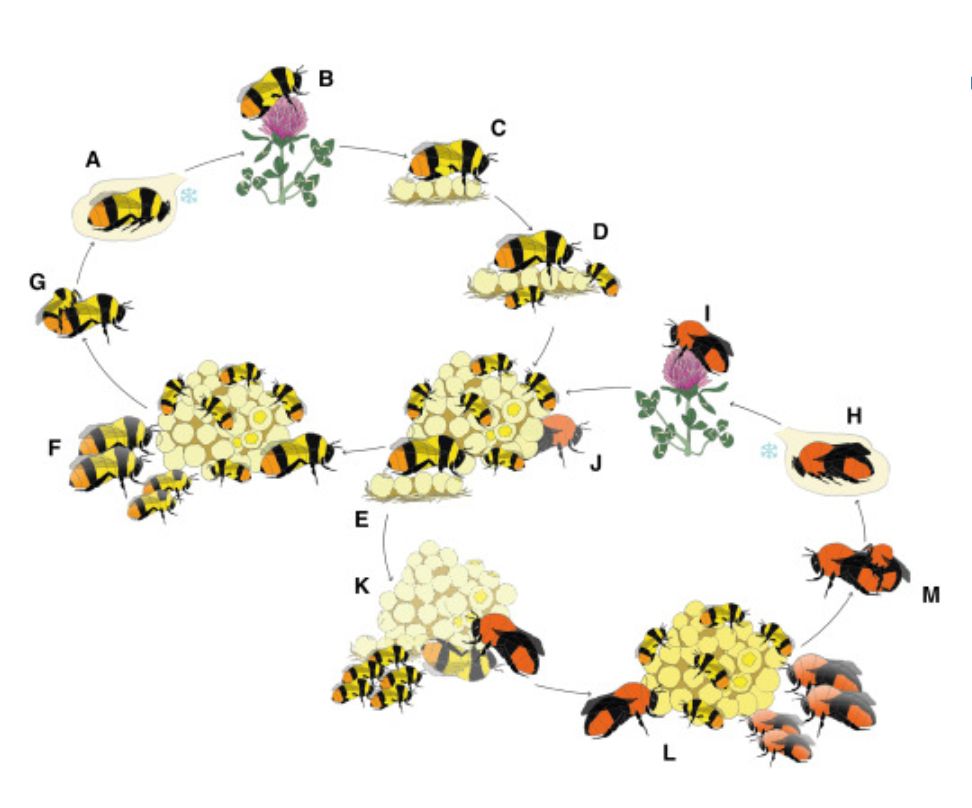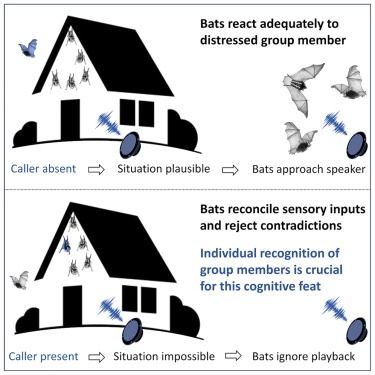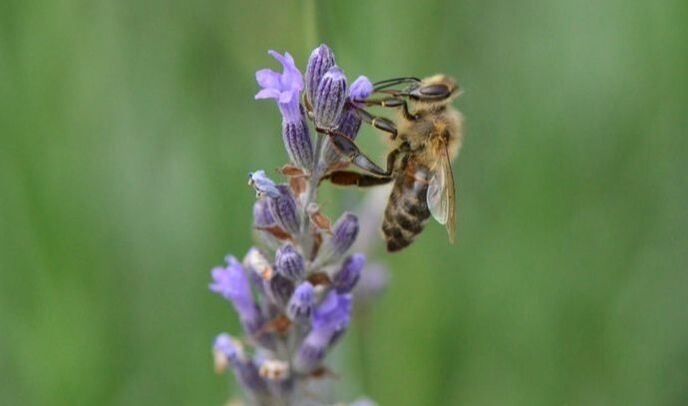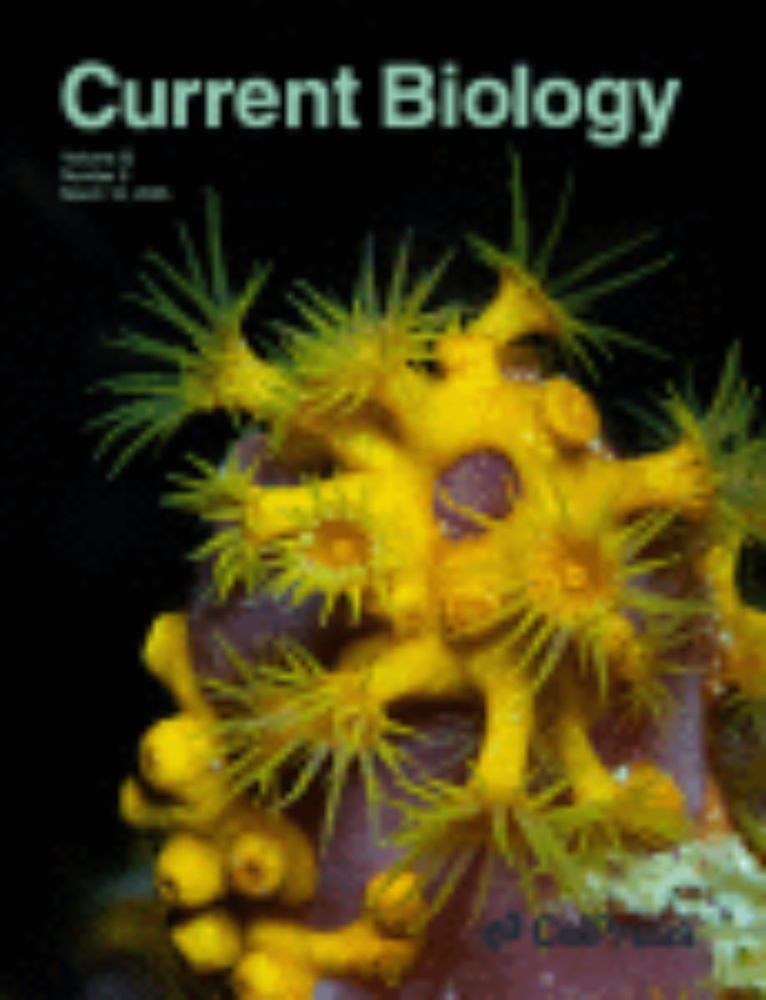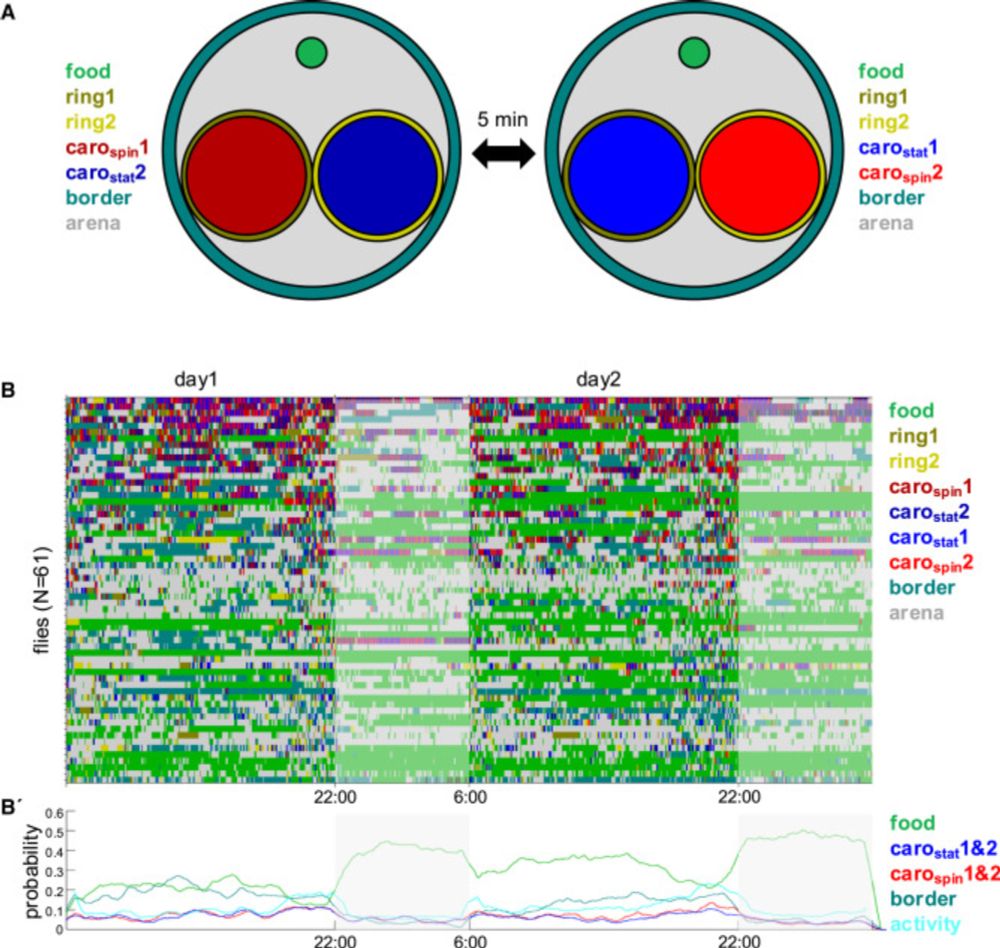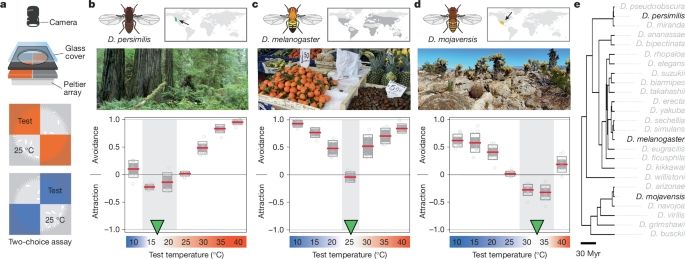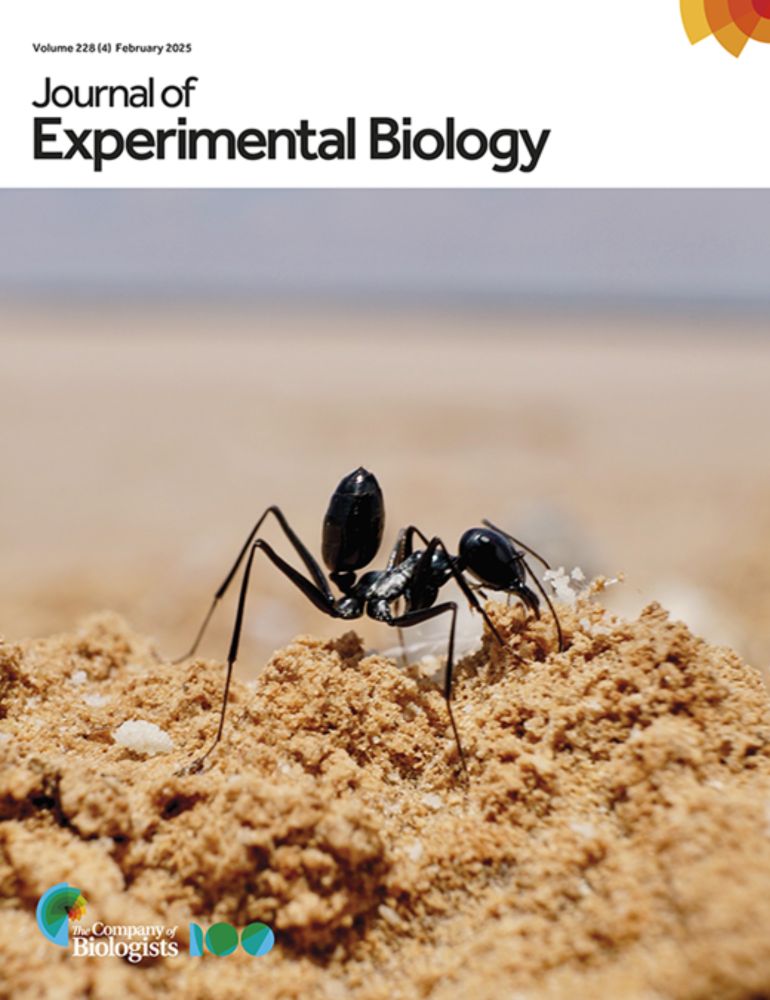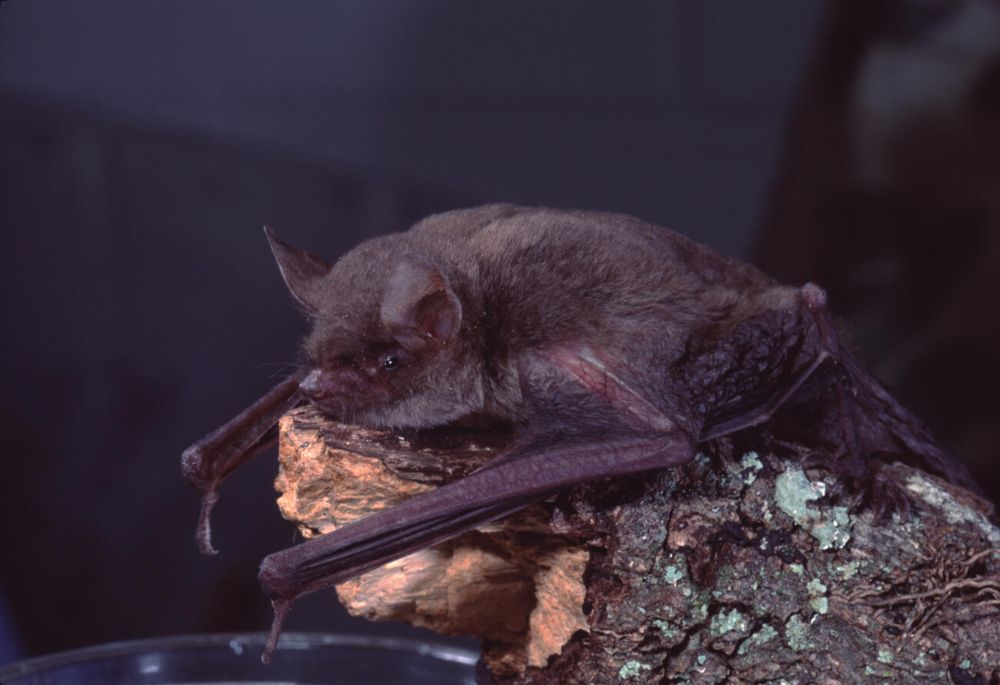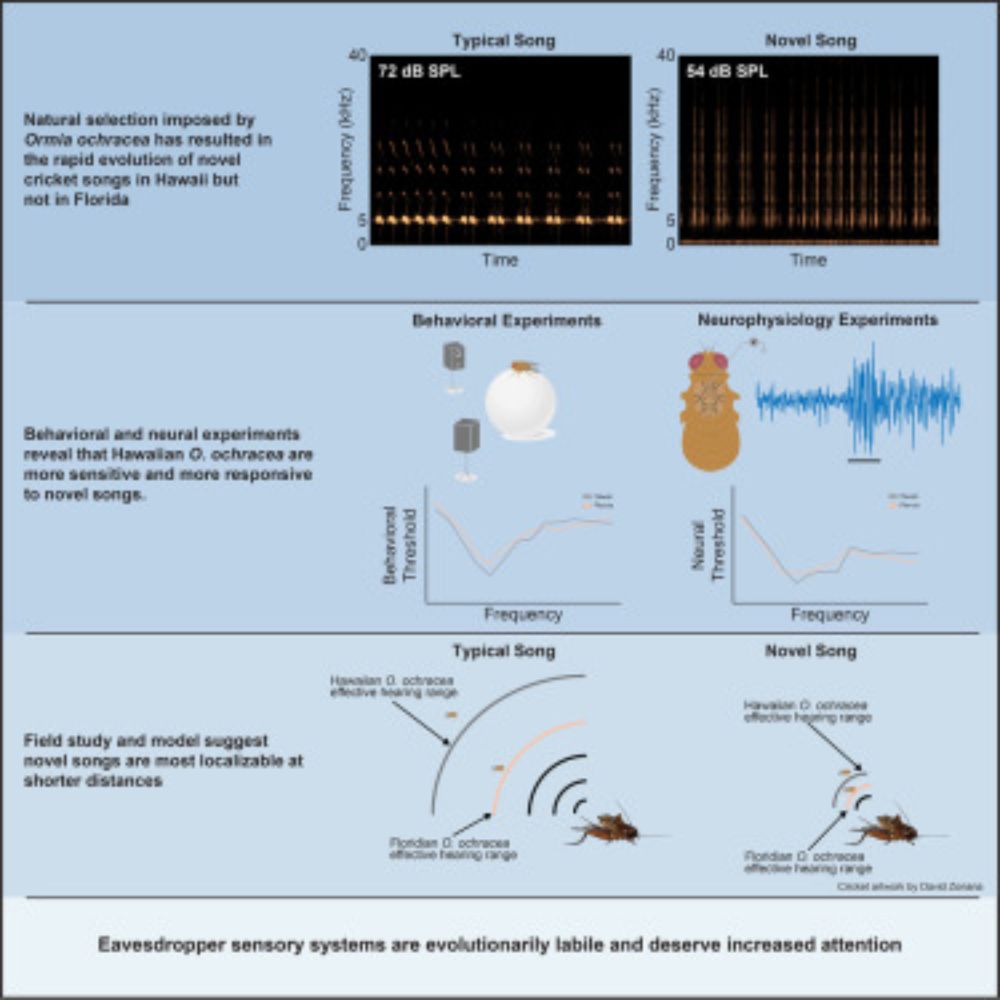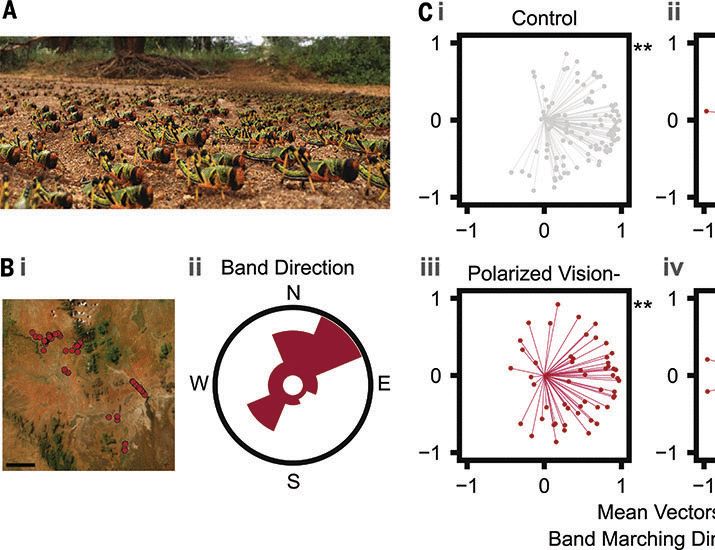International Society for Neuroethology
Promoting the study of the neural bases of behavior.
- The ISN Newsletter for May 2025 can be found here: internationalsocietyofneuroethology.growthzoneapp.com/ap/CloudFile...
- Reposted by International Society for Neuroethology[Not loaded yet]
- Reposted by International Society for Neuroethology[Not loaded yet]
- Thanks to the organisers for a great #neuroethology meeting: @martingiurfa.bsky.social @manuperisse.bsky.social Aurore Avarguès-Weber & German Sumbre 🤩🧠🧪♥️🇫🇷
- The last session was opened by 4th plenary speaker Adrien Meguerditchian on gestural #communication 🙈🙊🙉 followed by Catherine Macri on trace #conditioning 🐝 @ybecker.bsky.social on #language #evolution 🐒🦍🦧 and Adrian Ponce-Alvarez on critical behavior of mammalian brains 🧠
- The last session was opened by 4th plenary speaker Adrien Meguerditchian on gestural #communication 🙈🙊🙉 followed by Catherine Macri on trace #conditioning 🐝 @ybecker.bsky.social on #language #evolution 🐒🦍🦧 and Adrian Ponce-Alvarez on critical behavior of mammalian brains 🧠
- After #postersession and lunch, third plenary speaker @cataglyphilosophy.bsky.social kicked off the afternoon sessions talking about #magnetoreception 🐜 Afterwards Elena Kerjean spoke about #foragingecology and learning theories 🐝 and Patricio Casanova about #evolution of #navigation 🐟
- After #postersession and lunch, third plenary speaker @cataglyphilosophy.bsky.social kicked off the afternoon sessions talking about #magnetoreception 🐜 Afterwards Elena Kerjean spoke about #foragingecology and learning theories 🐝 and Patricio Casanova about #evolution of #navigation 🐟
- In the second session, 2nd plenary speaker Elim Hong presented insights into mechanisms modulating #aversivebehavior 🐟 Then Silvere Giraud spoke about the #learning capacity of mosquitos🦟, Alexandra Martin about the #auditorycortex 🐭 and Julia Mariette about #pheromone processing in the brain🐝
- In the second session, 2nd plenary speaker Elim Hong presented insights into mechanisms modulating #aversivebehavior 🐟 Then Silvere Giraud spoke about the #learning capacity of mosquitos🦟, Alexandra Martin about the #auditorycortex 🐭 and Julia Mariette about #pheromone processing in the brain🐝
- The first session was started by 1st plenary speaker @crezaval.bsky.social discussing the exciting question whether sex or #survival is more important (for male flies) 🪰 followed by Paul Clemencon on #perception of mechanical and visual stimuli 🦗 and Nuria Romero on #graviception and orientation 🪰
- The first session was started by 1st plenary speaker @crezaval.bsky.social discussing the exciting question whether sex or #survival is more important (for male flies) 🪰 followed by Paul Clemencon on #perception of mechanical and visual stimuli 🦗 and Nuria Romero on #graviception and orientation 🪰
- ✨️ Now happening: The annual meeting of the French #Neuroethology Club in Montpellier 🧠🧪
- Reposted by International Society for Neuroethology[Not loaded yet]
- Sand wasps lay one egg in up to 9 spatially distributed nests and provide food to larvae in order of age. Depending on food size they can delay food provision and they can also flexibly adjust age sequence. www.sciencedirect.com/science/arti... @currentbiology.bsky.social
- ✨️ Now happening: The annual meeting of the French #Neuroethology Club in Montpellier 🧠🧪
- Open university professor (W3) position for #BehavioralPhysiology in Würzburg, Germany @uni-wuerzburg.de: ↘️ www.nature.com/naturecareer... ↙️ Share or apply 🤗 #InsectResearch 🧪🐝🐜🦟
- Really cool article in @pnas.org on #electroreception for #predatordetection gets well-deserved #CozzarelliPrize2024 🏅 Congratulations @samjakeengland.bsky.social and Daniel Robert 🥳🥳🥳↘️ doi.org/10.1073/pnas... ↙️
- 🥳 Dear #ISN community: Make use of that possibility and sure to link us @neuroethology.org - we will happily share your #neuroethology #research news 🧪🧠🤩💓 here on bluesky 💙🦋
- Reposted by International Society for Neuroethology[Not loaded yet]
- Reposted by International Society for NeuroethologyHappy to see this out now: Olfactory projection neuron rewiring in the brain of an ecological specialist: Cell Reports www.cell.com/cell-reports... In a team effort with @bentonlab.bsky.social 's lab we establish new genetic tools in #drosophila sechellia and compare single central brain neurons.
- Reposted by International Society for NeuroethologyNow out in #ProcB 🧪 Ancestral complexity and constrained diversification of the ant olfactory system 🐜 Expertly led by Simon Marty and Antoine Couto, funded by @leverhulme.ac.uk and @agencerecherche.bsky.social 🙏🏻 #socialinsects @bristolbiosci.bsky.social @cnrs.fr
- new from our project with Patrizia d’Ettore and Jean-Christoph Sandoz’s labs, led by Simon Marty & Antoine Couto, with Neven Brard and Erika Dawson - comparing the olfactory pathway across ants, from sensillae to specialised antennal lobe structures 🐜 www.biorxiv.org/content/10.1...
- Reposted by International Society for NeuroethologyDear colleagues fascinated by olfaction and taste! 👃🏾👅 We are happy to announce that the registration has started for the upcoming ESITO 2025 meeting taking place September 19-24, 2025 in Sardinia, Italy. Please register and submit your abstract here: events.gwdg.de/e/esito2025 Deadline: July 1st!
- Reposted by International Society for Neuroethology[Not loaded yet]
- Reposted by International Society for Neuroethology[Not loaded yet]
- Reposted by International Society for Neuroethology📢 Fully-funded PhD opportunity! Explore the links between social & communication networks in ring-tailed lemurs! Exciting fieldwork, interdisciplinary team, and innovative technologies! Apply now and join @primatenzentrum.bsky.social & @unigoettingen.bsky.social for this cutting-edge research!
- Reposted by International Society for Neuroethology[Not loaded yet]
- Reposted by International Society for Neuroethology[Not loaded yet]
- Reposted by International Society for NeuroethologyCool set of talks by early career researchers on the neural basis of behaviour! Organized by @neuroethology.org
- Reposted by International Society for NeuroethologySpread the word: we're #hiring! We have an open #research fellowship position for #postdocs with their own research idea: It includes an own budget, a #PhD student position and the possibility to conduct independent research on animal #navigation and/or #magnetoreception 🧭🦤🦇🐟⚛️🧪👩🔬! sfb1372.de/jobs
- Reposted by International Society for NeuroethologyToday, I signed my first contract as a principal investigator @uni-wuerzburg.de. My Emmy-Noether group can now officially start on 1st of May. If someone is interested working with me on the spatial memory of 🐝 as a PhD student or postdoc, contact me. More details: www.spatial-navigation.com
- Reposted by International Society for Neuroethology[Not loaded yet]
- Reposted by International Society for Neuroethology[Not loaded yet]
- Micro-CT has revealed that orchid bee sexes invest differently in their brain regions 🧠. These differential investments correlate with behavioral differences in the sexes and imply a causal link between brain architecture and sex-specific behavior! www.nature.com/articles/s41...
- Please mark your calendars and join us next May 20th in the next session of the webinar series "The future of Neuroethology". We will have a line-up of amazing scientists as usual, we will learn about locusts, newts and cichlids!
- Reposted by International Society for Neuroethology[Not loaded yet]
- What animals can sense electric fields? Some fish, sharks, and... The Drosophila larva! In this new cool paper from the Louis lab, they found that larvae perform robust electrotaxis, mediated by a pair of sensory neurons at the tip of the head! Learn more here 🪰⚡ www.cell.com/current-biol...
- Reposted by International Society for NeuroethologyI highly recommend this inspiring new book by Nahum Ulanovsky! A plea for neuroscientists to embrace “Natural Neuroscience”: use emerging technologies to uncover meaningful behavior and neural representations in free-roaming animals exposed to real-world stimuli. mitpress.mit.edu/978026204499...
- In this fascinating paper by the Long lab, activity was recorded from the vocal production region of the budgerigar. These neurons form a map of phonetic features just like in humans. This, however, was not the case in the homologous region of the zebra finch 🧠! www.nature.com/articles/s41... 🦜🗣️
- Reposted by International Society for Neuroethology[Not loaded yet]
- Reposted by International Society for Neuroethology[Not loaded yet]
- Reposted by International Society for Neuroethology[Not loaded yet]
- Reposted by International Society for Neuroethology[Not loaded yet]
- Reposted by International Society for NeuroethologyReally cool video. @ecomorph.bsky.social guides us through all eyes in the animal kingdom! Cephalopod (especially squid/cuttlefish) eyes are the most beautiful of course. www.youtube.com/watch?v=2vjm...
- Reposted by International Society for Neuroethology[Not loaded yet]
- Reposted by International Society for Neuroethology[Not loaded yet]
- Reposted by International Society for Neuroethology[Not loaded yet]
- Reposted by International Society for Neuroethology[Not loaded yet]
- The Journal of Comparative Physiology A announced Editors' and Readers' choice awards 2025. From mechanoecology to sensory physiology to olfactory navigation. link.springer.com/article/10.1... Congrats to all authors that contributed to the selected articles/reviews.
- The Johnston's organ (JO) is an important sensor of the multimodal insect antenna. Intracellular recordings of sensory neurons in moths revealed that the JO encodes angular velocity and position of the antenna. @jexpbiol.bsky.social journals.biologists.com/jeb/article/...
- Reposted by International Society for Neuroethology[Not loaded yet]
- Reposted by International Society for Neuroethology[Not loaded yet]
- Reposted by International Society for NeuroethologyReally pleased to this first ms by PhD Student Yi Peng Toh out on BioXriv in collaboration with @ebablab.bsky.social :)
- Evolution of the olfactory system during the radiation of Heliconiini butterflies biorxiv.org/content/10.1101/202…
- Reposted by International Society for Neuroethology[Not loaded yet]
- Please also check the primer which highlights the beauty of using Drosophila to unravel some secrets on the neural mechanisms of sleep.
- Did you know that insects sleep? A new study from @sdissel.bsky.social lab reported that neurons of the central complex (dorsal fan-shaped body) regulate sleep. Important findings towards dissecting the neural circuit of sleep in flies. journals.plos.org/plosbiology/...
- Reposted by International Society for Neuroethology[Not loaded yet]
- Reposted by International Society for Neuroethology[Not loaded yet]
- Reposted by International Society for Neuroethology[Not loaded yet]
- Reposted by International Society for NeuroethologyTwo PhD Scholarships to study Australian stingless bees 🐝 and crop pollination at the Hawkesbury Institute for the Environment at Western Sydney Uni - deadline March 31. Sounds like a great project - reach out with questions - I did my PhD in this lab! www.westernsydney.edu.au/schools/grs/...
- Have fun and enjoy the discussions! ♥️🧠♥️ Dear #neuroethology community members: If you present your research and post this, make sure to link us 👉 @neuroethology.org - we will be happy to share your posts 🤗
- Reposted by International Society for NeuroethologyNew Primer on Bumblebees now out in Current Biology (with Guillaume Ghisbain & Denis Michez): www.cell.com/current-biol...
- Reposted by International Society for Neuroethology[Not loaded yet]
- Reposted by International Society for Neuroethology[Not loaded yet]
- Reposted by International Society for Neuroethology[Not loaded yet]
- 🚨New paper out in @currentbiology.bsky.social by @berlinbatlab.bsky.social et al. " #Bats resolve conflicting sensory information for individual recognition" 🦇 #playback #vocalization ↘️ doi.org/10.1016/j.cu... ↙️
- Reposted by International Society for Neuroethology[Not loaded yet]
- Reposted by International Society for NeuroethologyLet me introduce our new lab homepage. www.spatial-navigation.com We are looking for PhD students and one Postdoc that can start in November 2025. Contact me if you are in to studying spatial memory of honeybees. @uni-wuerzburg.de @neuroethology.org
- How do flying insects (esp bees 🐝) utilize path integration to efficiently navigate 🗺️ complex, three-dimensional environments? How might optic flow 👀 mediate this? Find out in this fascinating review by Dr. Martin Egelhaaf & Dr. Jens P. Lindemann! link.springer.com/article/10.1...
- Male blue-lined octopods 🐙 take love bites to a whole new level! The much smaller male bites the female octopod, aiming for the aorta, envenomating her with deadly (to us 💀) tetrodotoxin, and preventing her from eating 🍽️ him! Fantastic work from The University of Queensland 🇦🇺
- Reposted by International Society for Neuroethology[Not loaded yet]
- Reposted by International Society for Neuroethology[Not loaded yet]
- Do you think cities are LOUD 🔊? Spiders seem to think so! 🕷️ Urban 🌆 spiders construct webs that lose energy at a much broader range than the webs of rural spiders 🌱 likely to avoid sensory overload! 🧠 by Dr. Brandi Pessman & @hebetslab.bsky.social www.sciencedirect.com/science/arti...
- Reposted by International Society for Neuroethology[Not loaded yet]
- Do you like your fries with mayo/ketchup? Some goffin cockatoos like to dip noodles in 🫐yoghurt! In this new study led by @zewaldj.bsky.social from @auersperga.bsky.social's lab, they report a new dunking behavior. Its function seems to be the enhancement of flavor 👩🍳🤌 www.cell.com/current-biol...
- In this fun paper from @wolfhuette.bsky.social lab, flies were allowed to spin on a carousel. While some actively avoided the spin, others were eager to voluntarily spin on the 🎠. Read more so you can also spin and learn more about play behaviors! 😵💫🪰 www.cell.com/current-biol...
- In this very nice paper, the Lohmann lab reports that the loggerhead 🐢 can learn to distinguish magnetic fields. Conditioning was not disturbed by oscillating fields, discarding a radical-pair based mechanism. Dive in to find out more about this mysterious behavior 🧭🔎🤨 www.nature.com/articles/s41...
- Check out this cool paper studying the evolution of temperature preference in different Drosophila species, from changes at the molecular receptor level to valence processing in the brain! 🔥❄️🪰🧠 www.nature.com/articles/s41...
- Many ant species show individual specific routes when foraging. @freirilia.bsky.social, @mmoberweiser.bsky.social et al. show that desert ants also reveal idiosyncratic routes, although inhabiting featureless saltpans in North Africa. journals.biologists.com/jeb/article/... @jexpbiol.bsky.social
- Reposted by International Society for Neuroethology[Not loaded yet]
- Reposted by International Society for NeuroethologyWhen bats can't hear... 🦇Plan B(at)🦇 ... they compensate by adapting their flight path and vocalizations. They flew lower, oriented themselves along walls and increased both the number and length of their calls, boosting the power of echo signals used for navigation. 🧪 hub.jhu.edu/2024/11/25/b...
- Flies from the genus Ormia parasite crickets which they localize by eavesdropping. Cricket songs have therefore rapidly diversed, in Hawaii . A new study @currentbiology.bsky.social gives insights into the rapid evolution in sensory tuning of an eavesdropper. www.sciencedirect.com/science/arti...
- Most animals detect light with their cephalic eyes. But there are also many animals with extraocular photosensors. In this study @jexpbiol.bsky.social, Matsuo & Matsuo found an extraocular photosensory structure in the gastropod Peronia verruculata. journals.biologists.com/jeb/article/...
- Reposted by International Society for Neuroethology[Not loaded yet]
- In most cricket species, females approach calling males. But, in the tribe Lebinthini a duet between ♂️ and ♀️ has been evolved. M. Phillips et al. found that the duet more likely evolved from a startle precursor than courtship behavior. journals.biologists.com/jeb/article/... @jexpbiol.bsky.social
- Reposted by International Society for Neuroethology[Not loaded yet]
- 🦗The behavioral mechanisms governing collective motion in #swarming #locusts : www.science.org/doi/10.1126/...
- Reposted by International Society for Neuroethology[Not loaded yet]
